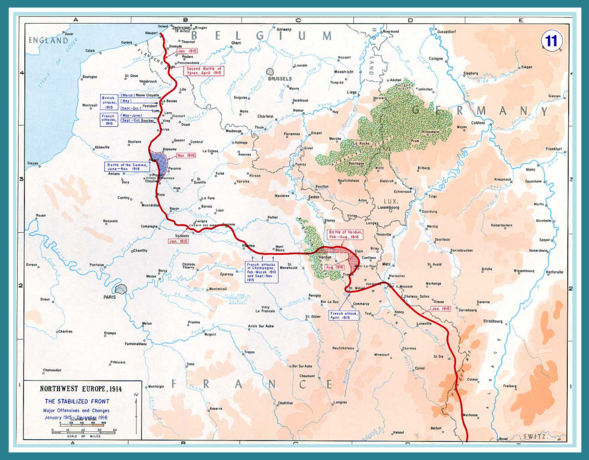
Western Front, 1915.
During 1915, several more Irish infantry units and formations arrived on the Western Front.
March 1915.
1/18th Bttn, London Regiment (London Irish Rifles) - 141st Infantry Brigade, 47th Division TF.
Remained with the Division in France and Flanders until November 1918.
May 1915.
1/8th King's (Liverpool) Regiment (Liverpool Irish) - 154th Infantry Brigade, 51st (Highland) Division.
Transferred to 165th Infantry Brigade, 55th (West Lanacashire) Division in January 1916.
Transferred to 171st Infantry Brigade, 57th (2nd West Lancashire) Division in January 1918.
August 1915.
2nd Bttn, Irish Guards - 2nd Guards Brigade, Guards Division.
Transferred to 4th Guards Brigade, 31st Division in February 1918.
Transferred to GHQ Reserve in May 1918.
October 1915.
36th (Ulster) Division arrived in France and were initially attached to 4th Infantry Division, before taking over a sector of the front, south of the River Ancre, during early 1916.
December 1915.
16th (Irish) Division arrived in France and moved to the front line near to Bethune.
In 1915, the realities of trench warfare were to be revealed. Outside the Western Front, the Germans had their problems in the east; their aim was to the defeat the Russians decisively, while remaining on the defensive in Frances and Flanders. Joffre, for his part, unduly optimistic.
By the end of 1914, the BEF was reorganised into the 1st (Haig) and 2nd (Smith-Dorrien) Armies, with a total of 11 Infantry Divisions (British and Indian), excluding Allenby’s Cavalry Corps and the Indian Calvary.The British Armies especially continued for a long time to be short of war material; and Kitchener’s appeal for volunteers, enthusiastically taken up. The Territorials had to be used to reinforce the BEF or relieve troops overseas.
During the first two months of 1915, the armies settled down to trench warfare, with engagements taking place at Cuinchy, Givency and St Eloi.
Among reinforcements were 27th Division (incorporating battalions from overseas); in its 82nd Brigade were 1st Royal Irish, 2nd Royal Irish Fusiliers and 1st Leinsters.
At Givency, on 25th January 1915, local reserves, including companies of the 2nd Munsters, drove back the enemy, who had penetrated to beyond the support line. South of the Canal, where the enemy had initial success, a local counter attack by the Coldstream, with two companies of the Irish Guards, regained lost ground at the “Railway Triangle”, east of Cuincy (1st February).
On that day, L/Cpl Michael O’Leary of the Irish Guards, won the VC, for capturing two enemy barricades practically by himself, killing eight Germans and capturing two. He “rushed along the railway embankment above the trenches, shot down five Germans behind the first barricade…then three more manning a machine gun…” The Military Cross had been instituted at the end of December 1914 and Lieut the Hon HQ Gough was the first officer in the Irish Guards to receive it.
On 14th March, the enemy, firing two mines, made a surprise attack at St Eloi and made some gains including the capture of the village. A counter attack by 82nd Brigade retook St Eloi and the Army Commander, General Plumer, considered that “the Royal Irish defended the village of St Eloi in a most gallant manner.”
About this time, a bayonet charge by 2nd Royal Irish Fusiliers was depicted by the artist “Snaffles” accompanied by Kipling’s lines:
"There were lads from Galway, Louth and Meath,
Who went to their death with a joke in their teeth."
Not really ready for any major offensive, the British, out of loyalty to Joffre, staged an independent spring offensive, the Battle of Neuve Chapelle (10th to 13th March).
On 10th March, attacking in conjunction with 8th Division of 4th Corps, the Meerut Division captured Neuve Chapelle, tactical surprise having been achieved. 1st Royal Irish Rifles, with 2nd Rifle Brigade, carried on the advance; objectives beyond the village were reached and fifty prisoners taken.
Later, German counter attacks recovered some of the lost ground but Neuve Chapelle remained in British hands. The 1st Irish Fusiliers attacked with great elan over the same ground where, in the previous October, their 2nd Battalion had suffered so heavily – “Captain Fergus Graham ‘capping’ the two leading companies with cries of ‘Hoike! Forard!’ punctuated with long blasts on a French postmen’s horn.”
But by the end of the battle, the Battalion had lost 409 of all ranks. The first “planned British offensive” had achieved initial success but then delays caused over forward movement and communications had prevented forward progress. The Allies were now in reality confronted by siege warfare; 8th Division’s losses were 5,000 (out of 12,000 between four divisions).
Source: "A History of the Irish Soldier", Brigadier AEC Bredin DSO MC DL.

